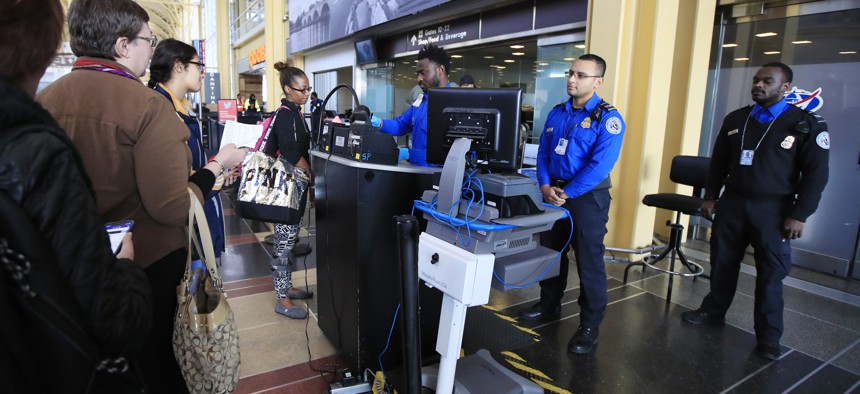
Transportation Security Administration (TSA) officers check and watch airline passengers at Reagan National Airport in Washington, Thursday, Dec. 27, 2018. AP Photo/Manuel Balce Ceneta
One in Five TSA Screeners Quits Within Six Months
TSA administrator says low pay is to blame and promises new compensation system soon.
The Transportation Security Administration loses employees a rapid rate due to low pay and limited opportunities for career growth, according to a new report, though the head of the agency recently told Congress he plans to boost salaries for his front-line workers.
The frequent turnover among TSA screeners, known as transportation security officers, has negatively impacted the security of the aviation system, the Homeland Security Department’s inspector general found in an audit. Staffing shortages have lowered morale, further exacerbating attrition rates.
TSA hired 9,600 screeners in fiscal 2017, outpacing the nearly 8,100 officers who left the agency. However, about one-fifth of the new hires left within the first six months of their start dates, according to the IG. Danielle Bennett, a TSA spokeswoman, disputed that data and said internal TSA data show that figure was actually one-in-six, or 16%, of new hires. The agency spent $16 million to hire and train those workers, part of the $75 million it spent onboarding employees overall that year.
The agency has failed to demonstrate opportunities for employees to move from entry-level to higher-earning positions, the IG said, a problem employees identified as the top reason for moving on from their jobs. TSA has failed to act on that information in part because its management does not habitually use exit survey data to make more informed decisions. Employees through those surveys have also complained about low pay, an issue management is working to address.
TSA officials told the IG that employees at airports in competitive job markets can earn more money at a retail store or a sandwich shop than as an entry-level screener. Those screeners earn around $35,000 in starting salary, depending on where they work.
At a House Appropriations Committee hearing on Tuesday, TSA Administrator David Pekoske told lawmakers he agreed the agency’s screener attrition rate of 17 percent was too high and that low pay was partially responsible. He noted that pay and other issues affecting retention were “completely within [TSA’s] control,” due to the latitude lawmakers gave the agency when standing it up.
“What I am looking to do is to be able to exercise the full extent of those authorities to be able to improve job satisfaction with the workforce, to be able to look at overall pay and compensation issues so we begin to address them in a systematic way,” Pekoske said.
The administrator explained that he created a “blue-ribbon panel” to examine the options for addressing compensation, which he expects to hear from shortly. The IG said TSA promised to address pay issues by June 30.
Pekoske said he has also addressed the workforce development issue with the creation of a TSO career development plan to show employees where they could be several years down the line.
Many screeners never have that opportunity, however, as they are only hired on a part-time basis. Of the 9,600 officers TSA hired in fiscal 2017, more than two-thirds were part-time employees. TSA hires that way to work around flight schedules, according to the IG, who noted the strategy leads to an increased turnover rate. Part-time employees voluntarily leave TSA at a rate two to three times higher than full-time workers.
The auditors faulted TSA for failing to properly explain its demands and expectations for employees when they start. The agency also inadequately screens candidates as it does not have formal guidance on ranking candidates or properly documenting information about potential hires.
TSA also has failed to maintain an adequate hiring pipeline to fill vacant positions, the auditors said. It has relied on overtime shifts to make up for staffing shortfalls, but the IG found that higher use of overtime has led to lower job satisfaction, which in turn has resulted in higher turnover.
Pekoske on Tuesday pledged to “rightsize” TSA’s workforce, saying the agency plans to higher 1,000 additional screeners by October 2020 under President Trump’s budget plan. TSA plans to shed 11 percent of its headquarters staff and redeploy part of the $182 million in savings toward its frontline workforce. The administrator noted that despite the difficulties employees encountered during the recent 35-day shutdown, attrition rates since it ended have actually decreased. He added the agency is keeping a close eye on those statistics, as employees may have decided to leave but are waiting for the right time to do so.
The inspector general recommended that TSA make better use of exit survey data, do a better job of communicating career opportunities and increase screener pay—all of which agency management agreed to do.
“Improving retention, hiring, and training of TSOs would save costs and provide a more stable, mature, and qualified workforce to better secure the nation’s aviation transportation system,” the IG said.
Correction: This story was updated to reflect the number of TSA officers leaving within six months according to the IG is one in five, not one in four, and with TSA's alternative data.





